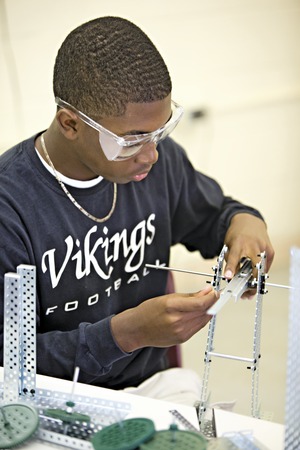
Welcome to the new age of career-oriented high school education, created by the National Academy Foundation, a privately funded venture. The effort is designed to give students exposure to and experience in a career field, preparing them for college or work.
Since 1982, academies have provided high-schoolers across the U.S. with focused curricula in areas such as finance, IT and health sciences. Now, NAF's newest program—the Academy of Engineering, or AOE—has just graduated its first class, a total of nearly 500 students in 12 schools.
Those schools are among a total of 62 engineering academies, stand-alone or within public or private high schools, that educated 11,000 students in the 2011-12 school year, says NAF.Curriculum collaborations with groups such as Project Lead the Way boost science, technology, engineering and math (STEM) skills for students, 71% of whom are from low- or moderate-income families. About 30% of those enrolled last spring were women.
Students are exposed to engineering principles and design, as well as robotics, architecture, construction, alternative energy and computer-aided manufacturing. They work on team projects and gain work-world experience through job shadowing, mock interviews, résumé writing workshops and a compensated internship.
"This model of education increased my confidence and communication skills," says Diana Ramos, a spring graduate of Harmony Magnet Academy, Porterville, Calif., and current biomedical engineering freshman at the University of Southern California in Los Angeles. "They concentrate on you, and the level of preparation ... is much higher."
Richard Charles, instruction director at the new Denver-area Institute of Science and Technology at Overland High School, which includes the AOE program, left a corporate engineering career at Sun Microsystems. "The transition was difficult, but the move gave me a more realistic perspective on what it takes to make it in the industry," he says. "These schools produce students who are focused on results while giving them a range of areas to explore."
According to Career and Technical Training LLC, a Colorado education consultant, some students receive college-level credit for completed studies through agreements with nearby community colleges. "Had I not studied at an academy, preparing for and getting into engineering would have been very hard," says Ramos. "It has taught me to be persistent and patient and not give up when tough college courses are discouraging others around me."
Noting the success of the first engineering-academy graduating class, NAF's associate vice president of programs, Bill Taylor, is optimistic. "We are aiming to produce 100,000 college-ready graduates by 2020," he says.
| School / Location | # of Grads |
|---|---|
| High School for Construction Trades, Engineering and Architecture, Queens, N.Y. | 68 |
| A.J. Moore Academy, Waco, Texas | 18 |
| Phillip and Sala Burton Academic High School, San Francisco, Calif. |
15 |
| Columbus East High School, Columbus, Ohio | 22 |
| University High School, Los Angeles, Calif. |
104 |
| Evergreen High School, Seattle, Wash. |
56 |
| Frederick Douglass High School, Atlanta, Ga. |
38 |
| H. Grady Spruce High School, Dallas, Texas |
34 |
| Harmony Magnet Academy, Porterville, Calif. | 57 |
| James Madison High School, San Diego, Calif. |
16 |
| Northwest Career & Technical Academy, Las Vegas, Nev. |
47 |
| Patrick Henry High School, San Diego, Calif. |
40 |
| SOURCE: National Academy Foundation |

Post a comment to this article
Report Abusive Comment